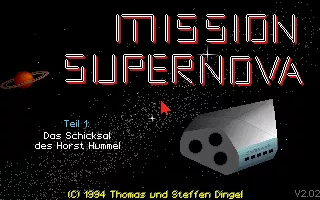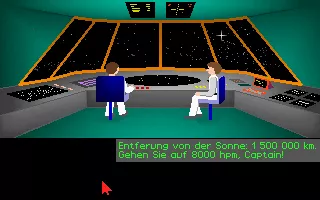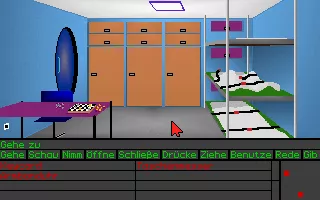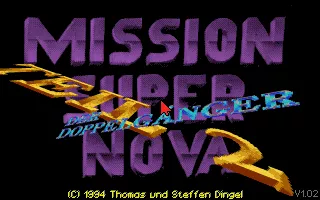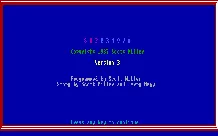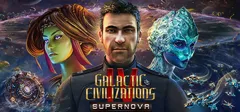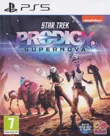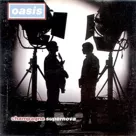Mission Supernova
Description
Mission Supernova is a shareware adventure in German. The player is "Horst Hummel", the spaceship's chef de cuisine. Usually this would be a job without much stress, but when you wake up, the whole crew is gone. You're alone on board.
The game is a classic point & click adventure. It features a verb-based interface very similar to early LucasArts games, e.g. Zak McKracken or Maniac Mansion. Like in those games, gameplay mainly consists of exploring rooms/scenes, collecting various items and solving puzzles. Some items can be combined to form new items, and most of the puzzles require clever use of collected things. From time to time, talking to other characters is also necessary, which involves choosing among different dialog options. Some scenes have a time limit, and it is also possible to die or get stuck in various ways.
Scenes are rather static, there is no scrolling in rooms. The main character itself is not visible in game, somewhat similar to Myst, although the perspective is not really first-person. You can interact with items at the other side of the room without actually moving there.
Mission Supernova is split into two episodes. The first episode was available for free, whereas the second one had to be ordered for money (shareware model). Meanwhile, both episodes can be downloaded for free.
Groups +
Screenshots
Credits (DOS version)
10 People
| Story | |
| Graphics | |
| Programming | |
| Music | |
| Testing |
Reviews
Players
Average score: 2.9 out of 5 (based on 3 ratings with 1 reviews)
Minimalistic old-school adventure game
The Good
At first sight, classic point & click adventure games may seem rather dull compared to modern games and their permanent onslaught of high quality audiovisual stimuli. Nevertheless, in their golden age, they were among the most immersive games one could find. As we all know, computers these days were not even remotely capable of the spectacular presentation offered by modern games - scenes were relatively static, had only few colors, characters were talking in text only, and sound or music were used rather sparingly. Nevertheless, you could easily get lost in these games, exploring strange worlds and trying to solve the next mind-boggling puzzles. I remember spending hours and hours with some of these, completely immersed in the worlds unfolding before me. All that despite the minimalistic presentation.
Mission Supernova is such a classic adventure game. The gameplay very closely resembles old LucasArts games: By using a verb based interface, you can pickup and use items and move around rooms. But it's even more minimalistic than those games. Maniac Mansion, LucasArt's first graphical adventure game, already featured large scrolling rooms, and player characters. Mission Supernova has neither. Rooms are always represented by a single background image at a time (with some animated areas), and there is no visible player character (although there are NPCs).
The latter fact actually feels somehow weird, because most of the rooms still look like regular (adventure game) rooms - places where a person would need to move to a certain spot in order to perform some action there, like pressing a button. But everything is instantaneous, as if your character would exist at every location in space at the same time. In many rooms, this is probably supposed to provide a "first person perspective" feeling, and most of the time this works quite well, but there are also scenes where you see rooms from an overhead perspective. And you still don't see your character. There is not even a single dot without animation or something - just the room and maybe other characters. The whole game is essentially reduced to the bare minimum of point & click gameplay: Picking up and interacting with things in a room, and moving between rooms. It's actually nothing big after you get used to it - but a bit strange when you've played other adventure games before.
The game's main focus is of course on puzzle solving and exploring - and that's also it's strongest aspect. It usually goes like this: You start in a new area with no exact idea what you have to do. Then you begin exploring, and find certain things. During exploration, you find ways to open doors, reach new areas, or get a better idea of what you need to accomplish. Most of the puzzles are pretty well executed, and rather logical (well, at least if you're an experienced adventure gamer). Most of the time, examining items using the "look at" verb reveals enough clues to get an idea on what to try next. Unfortunately, there are some of those ugly trial-and-error moments. One especially bad one is where you have to examine a certain picture in a room to find something hidden beneath it - and there are like 10 of these pictures, all looking exactly the same. But most of the time, the game works rather logical. Generally, rooms appear to be well thought out. In the crew chambers on the space ship for example, there are lockers and bunks. The leftmost locker will always correspond to the topmost bunk, the one in the middle to the bunk in the middle etc. - just like this would probably be organized in reality.
From time to time, you will be required to enter codes or similar data into computers, and there is always a real text input field in these cases. So you actually have to find the right input text, write it down on paper and then enter it, letter by letter, reminiscent of old text adventures. This is also used to get to places in the second episode - you find an address and enter it into a taxi's board computer to reach that particular destination. For me, it adds an interesting touch to the game, and it's a nice trick to make the game's world appear bigger and more real.
Especially in the later parts of each episode, there are some fast paced sections which have a more action oriented feel, and these are also very well executed. For example, there's a sequence where you have to break into a museum in order to steal an important artefact. A guard patrols the museum, taking a certain amount of time in each room, and some rooms trigger an alarm if you stay in there for too long. You are provided with the museum's floor plan and have to come up with a strategy to avoid the guard. It's a pretty fun sequence, which seems hard at first but is pretty easy after you find out how to do it. Those scenes break up the rather relaxed puzzle solving and give you that "final boss" feeling.
A final word on the graphics: The look and feel is somewhere between cartoonish and pseudo-realistic. It's sometimes coming off a bit too "home made", but always fitting the game and working well enough. They also have a certain charm to them, maybe especially
due to the imperfections. Also, some of the scenes are really full of lovely little details.
The Bad
While I generally like the game as such and playing through it was fun, I really hate the dialogs. They are mostly silly, uninspired and simply not well written. The humor is not my taste, and I did not find it funny at all. Sometimes the dialogs try to emulate some of the game's adventure game role models, but fails pathetically. It is just not the same level of clever and funny dialog as seen in many LucasArts games. Also, the ending was somehow stupid and not very rewarding.
Gameplay wise, especially the first episode is a bit too punishing - you can die pretty easily and because of really stupid things like opening an airlock without putting on a space suit first. To me, this should result in a warning from your player character, not death. Especially because there is absolutely no challenge involved in realizing how to prevent the failure. In the later parts of the game, you can die if you are not careful or too slow, which is perfectly o.k. for me, since it's part of the challenge. But the airlock thing? Reminding me I have to put on that helmet before pressing that button - by forcing me to reload the game? Come on. Well, it's most likely meant to introduce you to your ingame mortality early on. And actually, you cannot lose any real progress at that point. So maybe I'm making this one too big. But still, it annoyed me, and it's not the only stupid death in the game.
The Bottom Line
Mission Supernova is a very classic point & click adventure game with some nice little extra touches. The dialogs are not good and the graphics cannot exactly be described as beautiful art - but the puzzles are great and playing through the game was fun for me. It's available for free anyway, so if you're looking for something neat to waste time on a boring train ride or similar, and you like good old adventure gaming, go for it.
DOS · by lethal_guitar (618) · 2012
Analytics
Upgrade to MobyPro to view research rankings!
Related Sites +
-
Author's Homepage
The programmer's homepage. Here you can download the complete game for free. -
Download Mission Supernova
You can download the shareware version here for free. Beware though: The game is in German. -
Horsts gute Stube
an inofficial fanpage. The title refers to the main character in the game. "Horsts gute Stube" would be "Horst's snuggery"
Identifiers +
Contribute
Are you familiar with this game? Help document and preserve this entry in video game history! If your contribution is approved, you will earn points and be credited as a contributor.
Contributors to this Entry
Game added by Isdaron.
Game added July 23, 2001. Last modified February 4, 2024.

